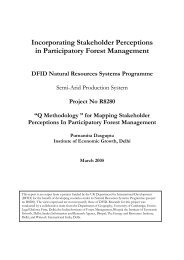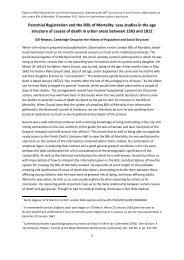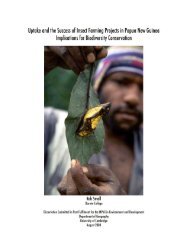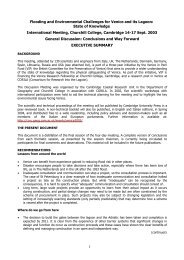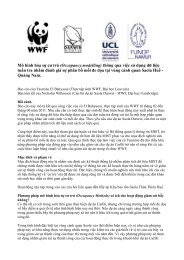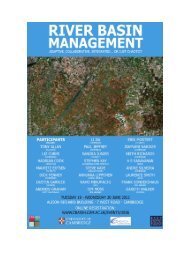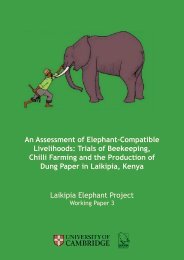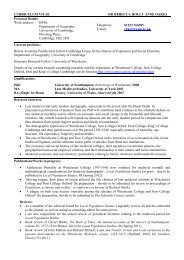Laikipia Elephant Project Working Papers - University of Cambridge ...
Laikipia Elephant Project Working Papers - University of Cambridge ...
Laikipia Elephant Project Working Papers - University of Cambridge ...
Create successful ePaper yourself
Turn your PDF publications into a flip-book with our unique Google optimized e-Paper software.
Crop Raiding Deterrents<br />
A smallholder farming area known as Salaama, located adjacent to the Rumuruti Forest in southwest<br />
<strong>Laikipia</strong> was selected as the site for this trial <strong>of</strong> farm-based deterrents. This site was one<br />
<strong>of</strong> three used for farm-based deterrent trials 2002-6 (See Figure 1). Salaama was chosen as a<br />
site to trial farm-based deterrents under UK Darwin Initiative project 15.040 because 1) farmers<br />
here were relatively settled and farming was less transient compared to the other two sites<br />
previously used; 2) uptake <strong>of</strong> the farm-based deterrents had been better in Salaama. Crop-raiding<br />
by elephants is a major problem in Salaama, because elephants leave the nearby Rumuruti<br />
Forest at night to raid crops on the surrounding smallholder farms.<br />
Twenty-five farms were identified to trial farm-based deterrents. Farms were selected on the<br />
basis <strong>of</strong> the willingness <strong>of</strong> their owners/occupants to participate in the trials and previous experience<br />
<strong>of</strong> human-elephant conflict. Of these 25 farms originally identified, the owners <strong>of</strong> 2 farms<br />
moved to a different area before materials and training for farm-based deterrents could be provided<br />
and so these two farms were not involved in the trial. From August to November <strong>of</strong> 2007<br />
the remaining 23 farms were provided with materials, training and ongoing outreach support to<br />
trial the following deterrents, adapted from Osborn and Parker (2002):<br />
(1) Chilli rope fences:<br />
two strand fences made from sisal string with any available timber used as posts were<br />
erected around cultivated plots (Figure 2). Squares <strong>of</strong> white mutton cloth were stretched<br />
and tied between the two strands <strong>of</strong> string at regular intervals. A mixture <strong>of</strong> ground dried<br />
hot chillies and engine grease was applied to the strings and squares <strong>of</strong> cloth.<br />
(2) Bicycle alarms:<br />
alarms emitting a loud noise were rigged up to a trip wire that surrounded the perimeter<br />
fence so that when broken the alarm would sound, waking up the farmer. Because <strong>of</strong> resource<br />
constraints materials and training were provided to 20 farmers so that they could<br />
erect bicycle alarms.<br />
(3) Chilli smoke briquettes:<br />
These are mixtures <strong>of</strong> elephant or cow dung mixed with hot chillies and a little water,<br />
then placed in a mould to dry in the sun (Figure 3). The briquettes were added to small<br />
fires placed on the perimeter <strong>of</strong> farms to create a noxious smoke that preferably blew<br />
into the direction elephants were likely to raid from.<br />
(4) Noise makers:<br />
‘Banger sticks’ were provided to participating farmers so that if an elephant did enter<br />
their fields they could scare them away by creating a very loud noise, similar to a gun<br />
shot ((Figure 4). Banger sticks are made by placing match stick heads into a hollow pipe<br />
with one solid end. A solid piece <strong>of</strong> pipe is then placed part way into the hollow pipe and<br />
cocked with rubber tubing fastened to a long stick. When the stick is smashed with force<br />
onto a hard object, the solid pipe hits the matchstick heads in the bottom <strong>of</strong> the hollow<br />
pipe, creating a very loud noise.<br />
(5) Watchtowers and solar powered torches:<br />
Watchtowers (6-9 m high) were constructed on farms located close to the Rumuruti Forest<br />
and the farmers who volunteered to man these watch towers were provided with<br />
powerful solar charged torches. Because <strong>of</strong> resource constraints only 5 watchtowers<br />
could be constructed.<br />
Twenty-five nearby farms were also selected to provide a control but only 19 <strong>of</strong> these were occupied<br />
and in use over the trial period and could be included in the analyses.<br />
<strong>Laikipia</strong> <strong>Elephant</strong> <strong>Project</strong> <strong>Working</strong> Paper 5 / Page 4




